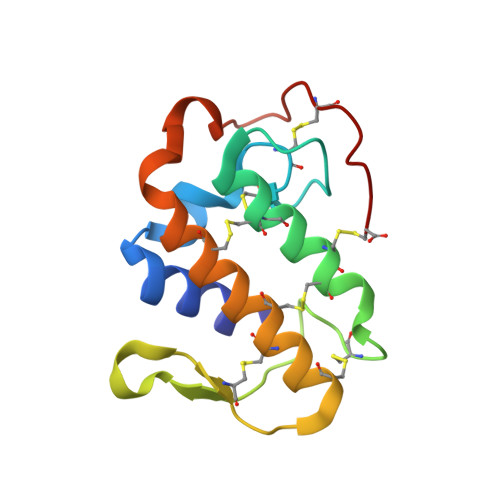Comparative structural studies on Lys49-phospholipases A(2) from Bothrops genus reveal their myotoxic site.
dos Santos, J.I., Soares, A.M., Fontes, M.R.(2009) J Struct Biol 167: 106-116
- PubMed: 19401234
- DOI: https://doi.org/10.1016/j.jsb.2009.04.003
- Primary Citation of Related Structures:
2Q2J, 3CXI, 3CYL - PubMed Abstract:
Phospholipases A(2) (PLA(2)s) are membrane-associated enzymes that hydrolyze phospholipids at the sn-2 position, releasing lysophospholipids and free fatty acids. Phospholipase A(2) homologues (Lys49-PLA(2)s) are highly myotoxic and cause extensive tissue damage despite not showing measurable catalytic activity. They are found in different snake venoms and represent one third of bothropic venom composition. The importance of these toxins during envenomation is related to the pronounced local myotoxic effect they induce since this effect is not neutralized by serum therapy. We present herein three structures of Lys49-PLA(2)s from Bothrops genus snake venom crystallized under the same conditions, two of which were grown in the presence of alpha-tocopherol (vitamin E). Comparative structural analysis of these and other Lys49-PLA(2)s showed two different patterns of oligomeric conformation that are related to the presence or absence of ligands in the hydrophobic channel. This work also confirms the biological dimer indicated by recent studies in which both C-termini are in the dimeric interface. In this configuration, we propose that the myotoxic site of these toxins is composed by the Lys 20, Lys115 and Arg118 residues. For the first time, a residue from the short-helix (Lys20) is suggested as a member of this site and the importance of Tyr119 residue to myotoxicity of bothropic Lys49-PLA(2)s is also discussed. These results support a complete hypothesis for these PLA(2)s myotoxic activity consistent with all findings on bothropic Lys49-PLA(2)s studied up to this moment, including crystallographic, bioinformatics, biochemical and biophysical data.
Organizational Affiliation:
Depto. de Física e Biofísica, Instituto de Biociências, UNESP, SP, Brazil.


















